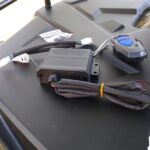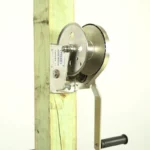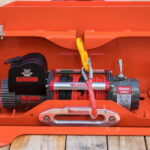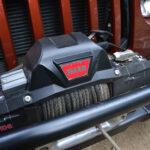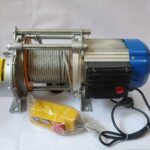Winches are great devices for hauling and moving heavy loads. They are mainly paired with heavy-duty vehicles like trucks, ATVs, UTVs, boat trailers, etc. Trailer winches have become increasingly famous as they facilitate the loading and unloading of heavy goods on boats. Powering a trailer winch can be a bit tricky if one does not have the proper knowledge. This article will contain all the necessary information one should know when powering their trailer winch.
How to Power a Winch on a Trailer?
Most boat and farm vehicle owners pair their boat trailers with winches to easily load and unload goods and items from their boats. Now, for the winch to operate, one needs to provide the correct power. There are various ways in which power can be supplied to the winch. People often tend to rewire to get sufficient current from the front hr 12 Volt accessory unit.
Though it is not the best way to power a trailer winch as on a 7-way trailer connector, the wire that provides power to the 12 Volt accessory circuit is not of sufficient gauge to permit adequate power to pass through to operate a trailer-mounted winch efficiently.
The accessory circuit is mainly designed to function for light-duty operations, like supplying power to the trailer lights inside or to a trailer-mounted battery.
The two most efficient ways in which a trailer-mounted winch can be powered are detailed below-
Have a Separate Battery
One of the first ways in which one can power their trailer-mounted winch is by installing a separate battery on the trailer. Normally the battery is mounted on the tongue of the trailer and is enclosed within the tongue box.
When using a separate battery to power the winch mounted on the trailer, one needs to take care of a few factors. Firstly, the type of battery that one opts for powering their trailer winch is an important thing to check out. Various types of batteries are available in the market with different amperes. A deep-cycle marine battery would be the best option.
Secondly, the application of the trailer winch needs to be determined. This refers to how frequently it will be used, the intensity of the work for which the winch will be used, and the storage of the vehicle on which the winch is mounted.
Thirdly, when drawing current from a separate battery, it is important to detect the current draw unload, as this would assist in determining the size of the wire and the fuse. A lead from the battery to the rear end and a good ground of equal size from the frame to the winch is required. Wiring it to a 30 to 50-ampere handle is recommended depending on the winch and the application of the winch.
A 4-gauge wire would be needed for a 50-ampere handle. If the winch is of less capacity, such as around 2000 pounds, a 10-gauge wire will be enough as it will not draw more than 30 amperes.
When using a separate battery for powering the winch, one needs to consider the 12 Volt system and the gauge of the wire, as voltage drop is expected while using the winch which, due to which a wire with a heavy gauge is necessary.
If the wire is not of sufficient gauge, the voltage drop can affect the service life of the trailer winch. If the trailer has electric brakes, which most trailers do have, power can also be drawn by up-scaling the break-away battery size.
A problem that can be faced when using a separate battery to provide power to the winch is that the battery can run out of power. The chances of the battery running out of power increase when the winch is used for heavy-duty applications. A simple solution for this problem would be to use a plug-in trickle charger.
In case the trailer is stored outside in the open air, a solar charger can be installed on top of the battery box. The solar charger would help in maintenance while the trailer winch is not used. Additionally, it can be connected to the 7-pin trailer, which would give a high charge rate to the battery.
Powering the winch by using a spare battery can be used for heavy-duty applications, though it is more suitable for general and light applications.
Use the Vehicle’s Power to Draw Power
The second method by which a trailer-mounted winch can be powered is by drawing power directly from the vehicle with which the trailer winch is paired. When using the power of the vehicle, a quick disconnect should be installed, which would facilitate drawing the power from the vehicle.
The 7-pin 12 Volt system can be used for maintaining the battery of the trailer, though it will not be able to charge a dead battery.
When using the power of the vehicle to power the trailer winch, it is recommended to use a battery isolator. The function of an isolator is to shut down the power supply to the trailer winch when the vehicle is turned off. Installing a battery isolator is important as it prevents the vehicle battery from being discharged.
The capacity of the trailer winch and the intensity of the application is also an important determinant. If the trailer winch is a heavy-duty winch, it would be drawing high amounts of electrical current when loaded up. This can result in a dead battery if some backup charging setup is not done.
It is recommended to operate a parallel circuit from the battery to the winch. The 7-pin connector on the trailer features a power circuit that will assist in keeping the battery charged when the trailer is being operated.
Generally, the power circuit on the trailer connection operates on a 30-ampere fuse in advance of the accessory fuse. A 175-ampere line fuse to the winch is suitable for the power leg of the battery.
The quality and gauge of the wire are the two most essential factors to consider when drawing power directly from the vehicle. If the winch is a high-capacity trailer winch, like 12000 pounds, using a heavy gauge wire is important. A heavy-duty 6-gauge multi-strand wire is the best for a high-capacity winch.
The 12 Volt system of the trailer is also an essential factor that one should not miss. While operating the trailer-mounted winch, voltage drop is considerable, which makes it more important to get a heavy-duty gauge. Also, the quick disconnects to be used must be of heavy-duty quality.
A simple configuration of the system that would help one meet their needs is to install a relay in-line that is normally closed with the 12 Volt AUX on the battery of the trailer. Then, connect an in-line disconnect switch with the trailer batter. By doing this, one is connecting the positive terminal on the winch and the switching input.
Summary
Powering a trailer winch is quite easy when one has the required knowledge about the mechanism of the vehicle and the trailer winch. The two most convenient ways to power the trailer winch are either by using a separate battery or by drawing power directly from the vehicle. Factors like the type of battery, capacity of the winch, application, wire gauge, and necessary precautions must be taken into consideration.
More on Winch


